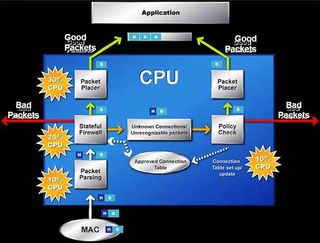NVIDIA Rushes Into PCI Express With nForce4
nForce4, nForce4 Ultra, nForce4 SLI
| Chipset | nForce4 | nForce4 Ultra | nForce4 SLI |
|---|---|---|---|
| Design | Single-Chip | Single-Chip | Single-Chip |
| Socket | 754/939 | 939/940 | 939/940 |
| CPU Support | Sempron, Athlon64 | Athlon64, Athlon64 FX | Athlon64, Athlon64 FX |
| HT-Link | 800 MHz | 1 GHz | 1 GHz |
| Memory | DDR400Dual-DDR400 | Dual-DDR400 | Dual-DDR400 |
| ECC Support | No | No | No |
| Max. Memory | 4 GB | 4 GB | 4 GB |
| AGP | No | No | No |
| PCI Express | 20 Lanes,16+1+1+1 | 20 Lanes,16+1+1+1 | 20 Lanes,configurable |
| PCI | 5x 32 Bit PCI 2.3 | 5x 32 Bit PCI 2.3 | 5x 32 Bit PCI 2.3 |
| USB 2.0 | 10 Ports | 10 Ports | 10 Ports |
| Firewire/1394 | No | No | No |
| UltraATA | 2 UltraATA/133 Channels | 2 UltraATA/133 Channels | 2 UltraATA/133 Channels |
| Serial ATA | 4 SATA Ports 150 MB/s | 4 SATA2 Ports 300 MB/s | 4 SATA2 Ports 300 MB/s |
| RAID | SATA & UltraATA | SATA & UltraATA | SATA & UltraATA |
| Networking | Native GbE | Native GbE | Native GbE |
| SN Engine | No | Yes | Yes |
| Audio | AC97 7.1 Sound | AC97 7.1 Sound | AC97 7.1 Sound |
| Firewall 2.0 | Yes | Yes | Yes |
| nTune | Yes | Yes | Yes |
| SLI Support | No | No | Yes |
Active Armor With Firewall

Active Armor is the name for the first integrated hardware engine for network firewall operations. We don't need to mention the importance of securing your computer from unauthorized access. Now, there is a hardware unit that takes care of TCP/IP packet inspection.
Since conventional software firewalls running under Microsoft Windows consume a considerable amount of processing time (see image above), NVIDIA's approach is to take care of most of the steps required to parse and inspect network packets in hardware. While we did not have the time to do extensive testing of all the nForce4 features, we were at least able to confirm a noticeable drop in CPU usage under high network traffic conditions.
For further information, please consult the following articles, where we already took a look at NVIDIA's firewall:
- NVIDIA, SiS and VIA Bring on Chipsets for AMD Socket 939
- New and Improved: NVIDIA nForce3 250 Gb Chipset

Stay on the Cutting Edge
Join the experts who read Tom's Hardware for the inside track on enthusiast PC tech news — and have for over 25 years. We'll send breaking news and in-depth reviews of CPUs, GPUs, AI, maker hardware and more straight to your inbox.
Current page: nForce4, nForce4 Ultra, nForce4 SLI
Prev Page nForce4 Facts, Continued Next Page SATA: 4 Ports At 3 GBit/sMost Popular

